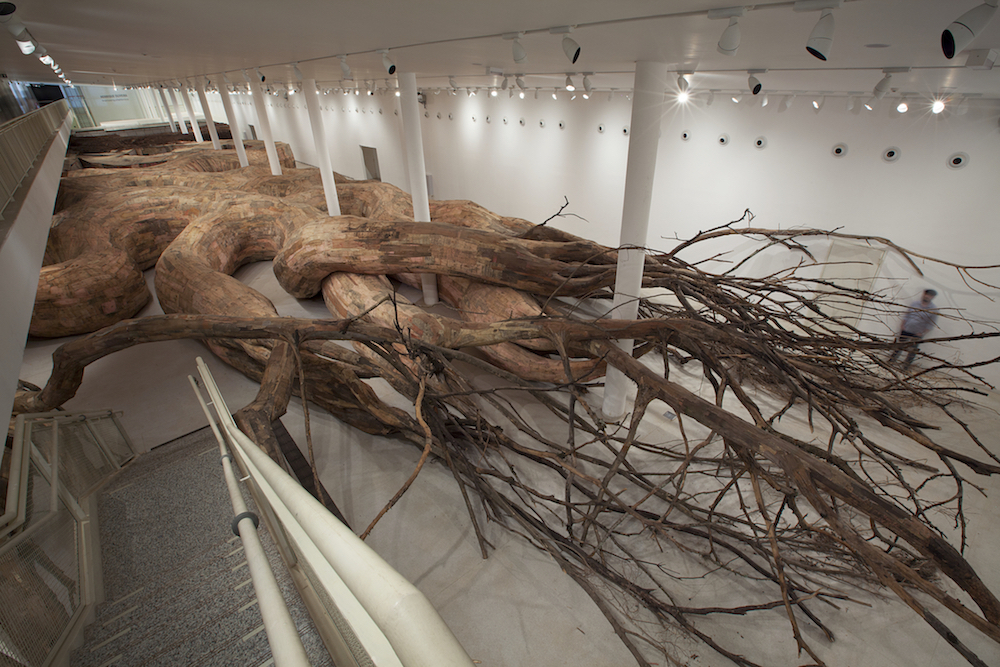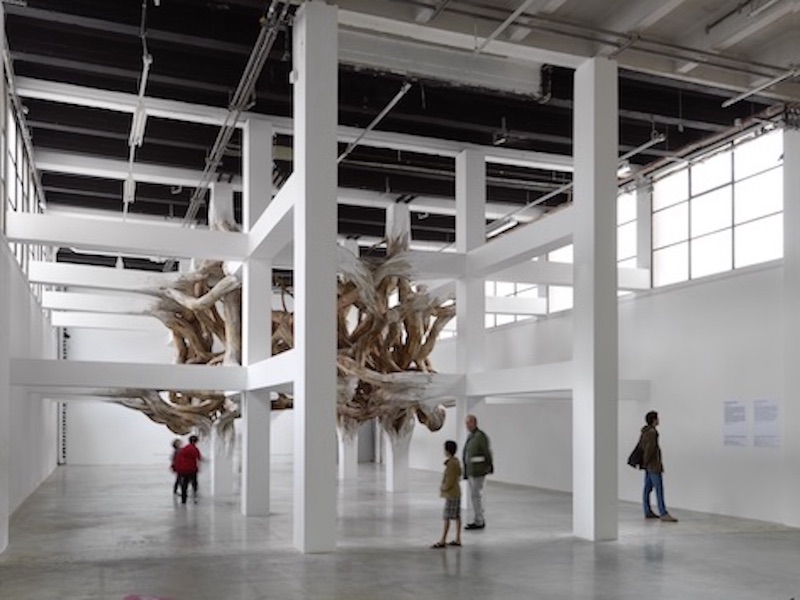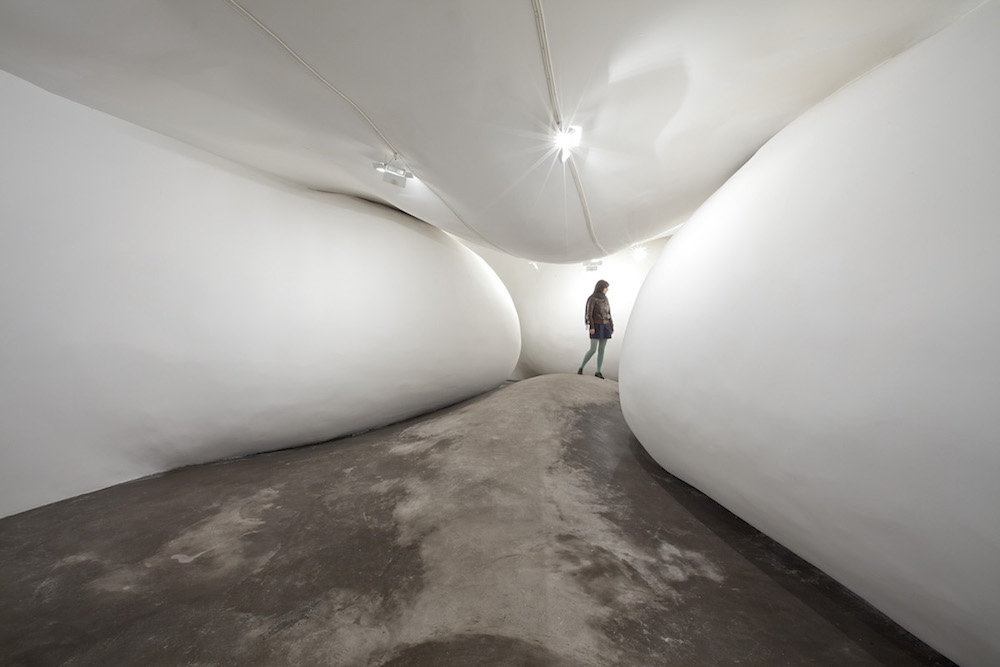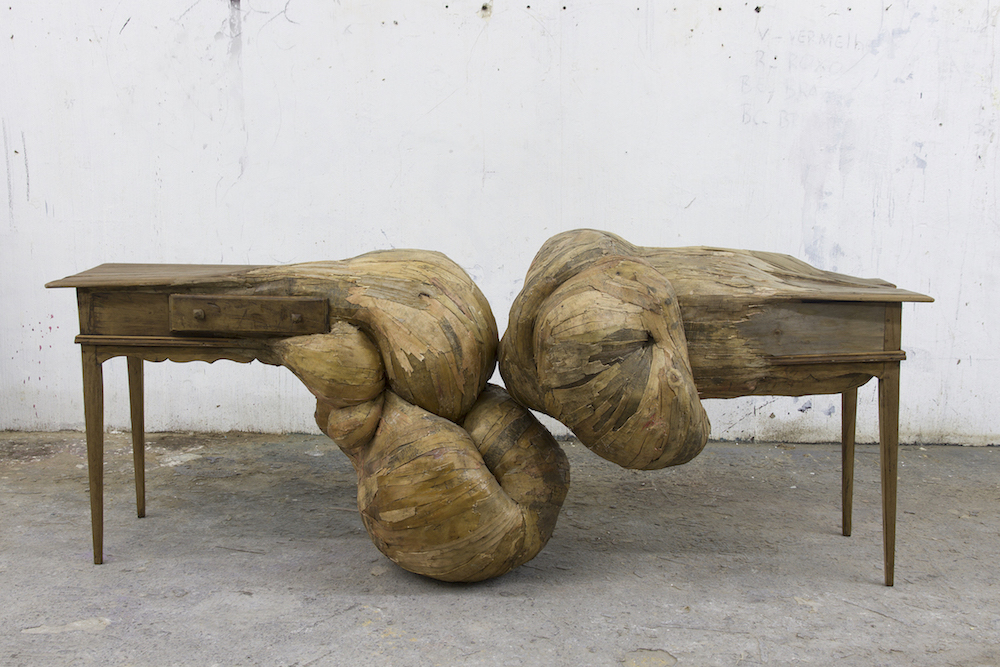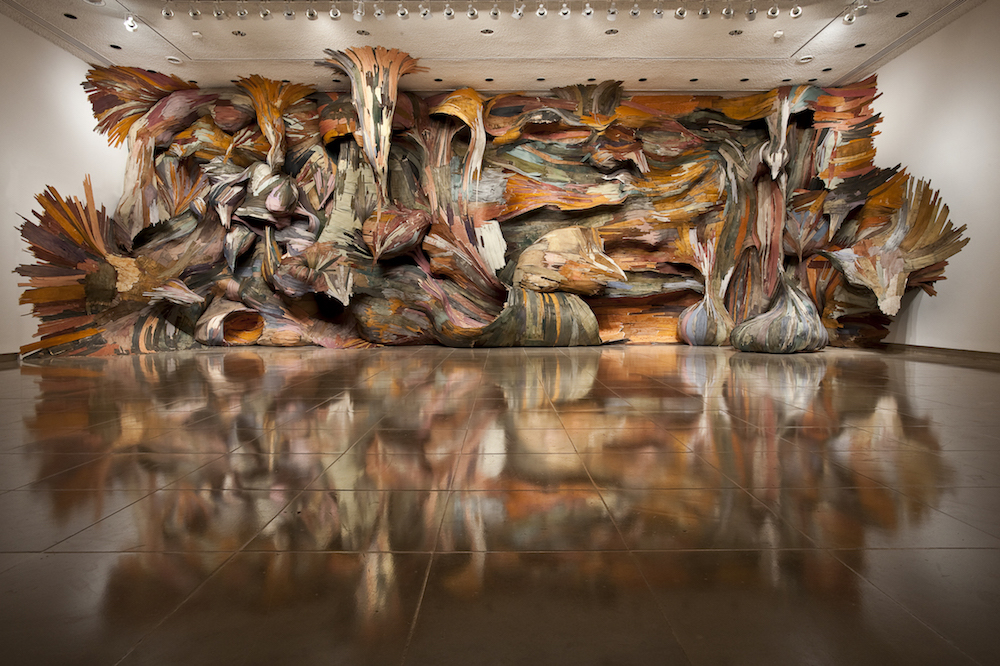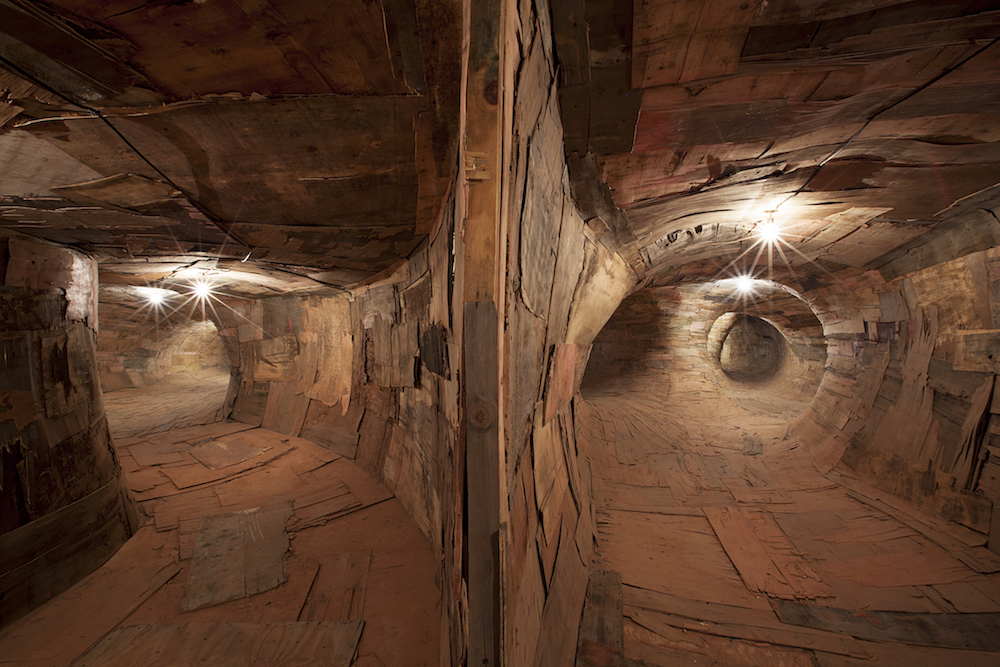Henrique Oliveira – Being & Form
Presented as wall reliefs, free-standing pieces or walking-in environments, Henrique Oliveira’s works are always hybrid forms, organic structures that merge with architecture or objects crafted to blur the limits with nature and destabilize codes of visual perception such as space, surface and consistency. Rather than making judgments over the disequilibrium of today’s human relations, they are presented as “growths” nurtured by the deteriorating residues of society, images that couldn’t have been thought of beforehand but can now appear as a side-effect of the contemporary world.
John K. Grande: Henrique, I appreciate your taking the time to answer a few questions. I believe the artist has a certain responsibility for their own experience, for their vision and to society. What has increasingly complicated the artist’s vision is the separation of the physical and material world from what we call art. Can you comment?
Henrique Oliveira: In the last decades our lives have become so mediated by images. Everything we see, our communication, all the forces that operate in our society act through a system of pixel combination. It’s a tendency that started with the invention of photography. If, as Walter Benjamin observed in “The work of art in the age of mechanical reproduction,” the process of multiplication of images would make art lose its aura as it became accessible to everybody in a socializing process, what we see today, by contrast, is that this technological process can be an instrument of political control over society. We live a paradoxical situation, if it’s true that there was an image revolution in the 20th century, it’s also true that this revolution was co-opted by the capitalist system. The logic of this system has been incorporated in every instance of our lives. Our behaviour has become standardized, our taste is supposed to follow certain patterns; even our image is a product for consumption on the social media.
When we stop and think about how we take all the information that arrives via a mediated computer screen or printed on paper to be true, then we begin to understand why it is so important to see things alive. I’m not saying that art works are not part of this system, on the contrary, the media has, more then ever, been used as an instrument of power. This development of image reproduction and manipulation, did not, as Benjamin predicted, destroy the aura of art. On the contrary, art has become an investment. A commodity, but one that is associated with status, fame, power and seduction – values that structure (as fragile as they may be) our present world.
But this problematic side of contemporary art also unveils a need for the real object. More and more people need to have, need to see something concrete and real amidst this frenzied flux of immaterial images. As the virtual world increasingly becomes part of our everyday life, the more we will search for material compensation.
People had to leave the fields and rural places and move to the big cities to start seeing value in nature. The same is happening with our increasingly virtual culture, people need to go and see art in museums, go out in the city and to the beach. I’m not saying that art needs to be material, a lot of important things are happening virtually, mentally only, and will continue to happen more and more. But we will always have to test the resistance of new ideas against the hard matter of the world.
People in general tend to understand technology in its literal sense – machines that change the way we communicate, the way we produce and transport things and so on. But it is much more than that. Technology is present with us all the time, even if we are naked in nature. It has already changed the way we feel about the world forever. I don’t see a distinction if we create 3-D print, if a factory produces something, if we re-arrange industrial objects, recycle them or if we craft an object – they are all products of today’s technology. Technology is not just using the machines: it is also in our heads, in our thinking.
I see your interest in painting evolved and then jumped right into sculpture. Are the two complimentary for you?
E. O. Yes and no. They are complementary to the extent that painting offers me a momentum when the intense search for ideas and new projects ceases and I then can be absorbed in a language that flows in a lighter and more immediate way. In this liquid medium, I see images appearing in front of my eyes as I work. The timing with painting is different in comparison to sculpture and installation. The latter usually needs sketches and days of hard work to make them visible. I know it seems like a prosaic statement, but many ideas for 3-dimensional works are conceived when I’m in the process of painting.
In another way, my sculptures have helped me to orient the choices I’ve made in painting. They share some common elements like surface, gesture, layering, colour, organic forms, and so on. Working on sculpture and installation is a way to maintain a distance from painting and, later on, return refreshed to the canvas.
Though they clearly influence each other, sometimes painting and sculpture installation seem to insist on being parallel practices. Though they have corresponding similarities, sometimes they behave like oil and water. Even if I force it, they don’t mix.
When I started painting, before attending art school, my production often relied heavily on my early drawings, which are the basis of my sculpture. Another part of my art making followed an experimental path… I would use materials as diverse as newspaper, earth and pebbles, tree bark, labels, even material collected from the trash or the fields. A few years later in art school, my painting became focused on the medium as I learned various techniques of sculpture, photography, printing… It was good to have had that moment. It helped me have a clearer vision of the next steps I would take towards a production less easy to classify.
The meaning and limits of such mediums and their implicit language have always guided my work. It is true that it has become less and less important to refer to traditional categories in contemporary art. More important than denying categories in art, is to overcome them in the work I make.
Is making sculpture a way of “painting the environment”?
E. O. We can use the term “painterly” for a variety of objects and surfaces, but painting, strictly speaking, is something quite specific. In my first installations, I used a combination of patches of used plywood to produce a continuous object comprised of a variety of textures and colours. Once put together on a wall, the material made it possible to speak of a painterly experience, of the work being “perceived” in another “non-painterly” medium; this similarity causes us to change the way we see the world, and increases our sensibility when looking at ordinary places and objects.
Later on, as my production evolved in a variety of directions, I followed this “pictorial” orientation and transferred it onto hanging objects. The move was from flat installations made directly on the wall, to 3-dimensional panels.
These 3-dimensional pieces are created through a construction process that often makes sculptural references, but the result is an object situated somewhere between sculpture and painting. Some people refer to them as reliefs, as they start from a particular kind of oil impasto technique that is the model due to its tactile dimensionality. Seen from this point of view, what once was derived from a representation technique, painting materiality becomes a universe unto itself. Taking a close look at that kind of textural effect, we start to see a vast “landscape,” which is neither a result of nature’s force nor totally intentional. From that moment, I could begin to think of a kind of “3-dimensional painting.” The sculpture installations became a sort of enlarged paint paste representation. And they had a “cover layer” made out of bits of jagged laminates that were overlayed to form a visual dynamics, generating a feeling of movement. The colours, applied as a kind of translucent filter or watercolour, don’t change the natural patina of the material’s surface – instead, they interact with the surface in a lower palette of tones and nuances characteristic of the material itself. Colour and material… but because it is virtually impossible for the construction to be a painting, the final result is a visual object that didn’t exist before and couldn’t have been thought of beforehand.
Does using plywood and found materials increase the point of contact with the community, at the same time as it also transforms the plywood into a new metamorphoses as art… an exciting process…
E. O. I don’t think it does, but it certainly provides a possibility of thinking about communities who don’t usually participate in the art world. Continuing with the example of the relief artworks I already mentioned, great monumental painting is what first comes to mind when one sees them. But if you look very carefully, you will realize that the size of these relief works is deliberate, and not the outcome of chance. Plywood is produced and conceived of for use on an architectural scale, or at least on that of the human body (as furniture). Once the spectator has realized what the actual material is, one is able to establish connections that go beyond mere visual qualities. One is able to think of situations and places that are at the other end of the spectrum of abstraction as it is represented in the canons of art. The plywood medium can be seen in the materiality of construction sites, in shantytowns, and is often found in derelict areas – on the peripheries of big cities, of society, of the art world.
This series of works, which I’ve grouped under the title of Xilempasto, allows this material to enter surreptitiously into the realm of the great artistic canons. Its use is not to fight against the institution; it just exists and while doing so, works as a kind of contamination of the process.
In site-specific works produced for public places like Tapumes – Casa dos Leões, or Alley Abscess, I proposed a parallel between the disorder of the human body and the social disarray inherent in exploited developing societies. Signs of decay are everywhere, in old rotten wood, rusted metal, dirty soil and materials taken from fields. Used in construction, these materials can be seen as tumorous formations, or symptoms of negligence. They are a metaphor for the sick body on the scale of architecture that contaminates a culture in which the spectacle is so prevalent. These installations are on the scale of the big signage that shapes our cities, and it contributes to a feeling of discomfort. It brings out a curiosity that may lead to deeper layers of interpretation.
Many people collaborated in making such works, but this is not as important as the power of the resulting material image. The metamorphosis of the materials interests me. I want these material metamorphoses to correlate with the changes in the way we see the world.
I would call the way your sculpture fits into architectures, spaces, as a kind of eco-Baroque, for in art the decorative and ecological can compliment each other… How do you see it?
E. O. You will never find me using the adjective “eco” in relation to my works. I don’t use only second-hand materials. I also use a lot of new wood, new materials, sometimes PVC tubes, sometimes foam, and so on. Even where you see salvaged wood, I had to use gas to drive around and collect it. I use paint, screws and all sorts of things. Often there is no destination for my work after a show and so it end up in the trash. Second, I think that the label “eco” today has very little to do with its original meaning. In our society “eco” is intended to add value to products and services. In other words, “eco” sells better.
When I was an art student I had a great interest in the Baroque, especially the Brazilian Baroque, which gave us great artists and beautiful colonial architecture. Today, we still can talk about some of my works using the term baroque, but in a more general way. Baroque as opposite to classical, or the Dionysian in opposition to the Apollonian… In this way, you may see my works as tending more to a Baroque mood. Going still further, you could also bring up the Portuguese origin of the term Baroque – the imperfect pearl. My handmade art is very much created out of this imperfection.
So many adjectives have been used to describe my works… I have received invitations to show in radically different contexts that include land art, street art, architecture and design and so on. Talking about my production, people have used terms as surrealism, formalism, soft art, Art Povera and now in your case, eco-baroque. As I keep relying on a variety of different sources, I won’t be concerned about labels. I will only start to worry if everybody uses only one adjective!
Do you choose the sites or do they occur by accident?
E. O. The places where I work are mostly by invitation, so I usually have a limited choice. Many times the site is a challenge, other times they are just white cubes, seen to be “neutral” spaces. This last kind of situation makes the work less site dependent and less site-specific but more site-oriented. Often, the site doesn’t impose conditions, but likewise the work tends to be autonomous of the site. Everything is possible and nothing stands in the way.
In looking at a work, there is always this push pull effect between reason or design and the flow of nature’s systems… A hidden message in many of your pieces is that we are participating in an artwork, merely adding another dimension or layer…
E. O. If I understand right, you mean that apart from the obvious works that you can enter, in many of my works the spectator is placed at a point of view to witness something that is happening, or that has happened already, or something that is changing, growing…
I think this weird sensation that sometimes people report to have felt, is the consequence of combining a construction process with natural or apparently natural material. Because the wood you see in my works is used, it makes you feel that the works are alive, or were alive at one time. Although these sculptural works are designed and crafted, they are not made of new materials, but because the materials have a history, they exist in the context of time. If they were made of new materials they would exist out of any context of time, made in opposition to something that like my sculpture installations is aging, is in the flow of time.
The realistic image is close to perfection in representing its referent in painting, and could be said to look alive. In sculpture, however, you know that a figure or object, although it may look real, is made of another material. In my wood constructions, the wood does not represent anything… It is presented as wood. My sculptures never have a precise design, and are made out of a freestyle hand-crafting process. And this also contributes to the perception or baroque feeling of a weird, imperfect thing. Such imperfections bring the work to life.
And the power of nature is evident in all of your sculptures… was there an influence or inspiration for this?
E. O. Nature has always played a central role in my life. I grew up in a town where I could go swimming in a river or walking in the woods almost everyday. And even after moving to São Paulo when I was 16, I kept travelling on weekends to go kayaking, trekking and to the beach. A biologist friend and I used to pay a lot of attention to nature and the environment during trips into the fields.
When I started working with used plywood, I had spent much more time in the city than I ever had in my life. Although I was using material associated with an urban context, I think the influence of nature appeared naturally as my works evolved.
The language of nature is seemingly infinite, while the manufactured product is limited in its variability. I feel your sculptures walk the line between the two in such an interesting way…
E. O. I would say that difference is unlimited in nature if compared to what is available in terms of human production. Being part of nature, man also has the potential to produce infinite difference. At the same time, humanity also knows that this is a potential that can never be fully achieved. As much as man can project and create, he can never grasp that horizon of infinitude that nature occupies in the human imagination. At the same time, it is perhaps this kind of “oceanic feeling” (to borrow a term Freud used in “Civilization and its Discontents” while describing the religious feeling) that keeps us moving. It is this infinite curiosity that makes it possible for us to talk about humanity and nature as being somehow different.
Henrique Oliveira was born in Ourinhos, Brazil in 1973. He graduated with a Master’s Degree in visual arts from Universidade de São Paulo, in the city of São Paulo, where he lives and works. www.henriqueoliveira.com/
John K. Grande has curated earth art and eco-art shows worldwide, at venues that include the Royal Botanical Gardens in Ontario, the Van Dusen Botanical Gardens in Vancouver, Pori Art Museum in Finland, Merano, Italy and Small Gestures at the Mucsarnok/Kunsthalle, Budapest (2016). www.johnkgrande.com/





